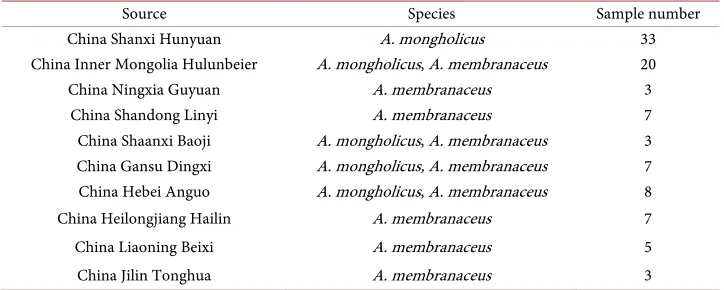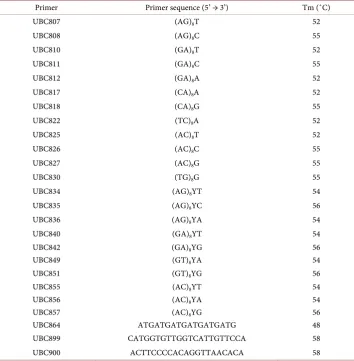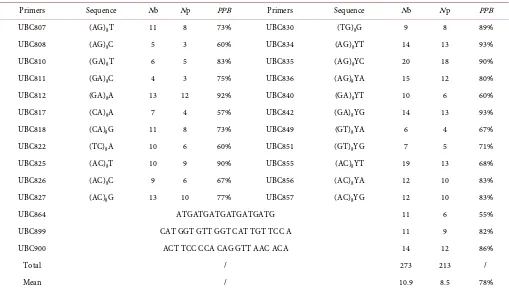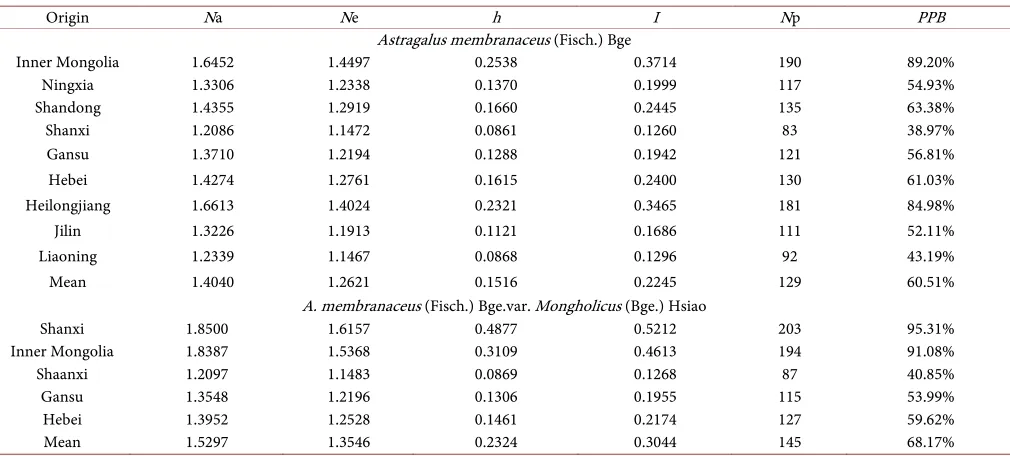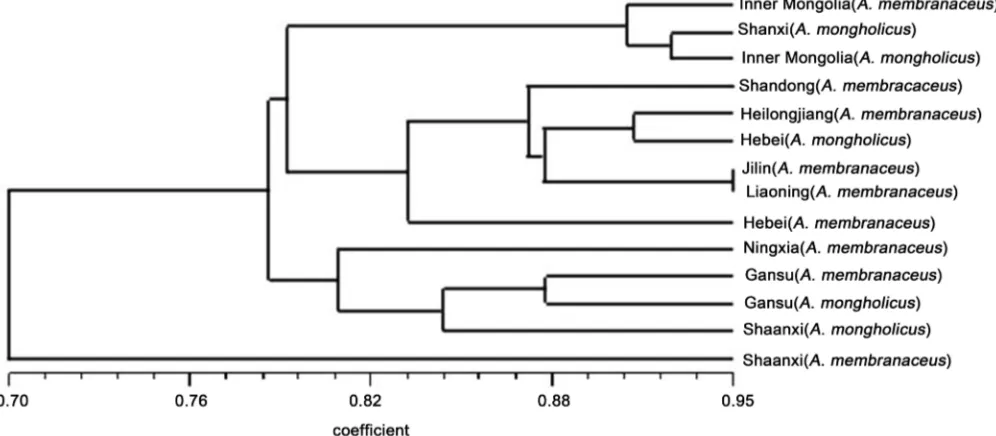http://www.scirp.org/journal/abb ISSN Online: 2156-8502
ISSN Print: 2156-8456
Analysis on Genetic Diversity of
Radix
Astragali
by
ISSR Markers
Yaling Liu
1,2, Pengfei Zhang
1, Ru Zhang
1, Meiling Song
1, Fengbo Liu
2, Wenquan Wang
2,3*, Junling Hou
3*1College of Life Science, Shanxi Agricultural University, Taigu, China
2School of Chinese Pharmacy, Beijing University of Chinese Medicine, Beijing, China
3Institute of Medicinal Plant Development, Chinese Academy of Medical Sciences & Peking Union Medical College, Beijing, China
Abstract
Radix Astragali has been an important traditional Chinese herbal medicine for over 2000 years. It is derived from two plant species, namely, Astragalus mongholicus [Astragalus membranaceus (Fisch.) Bge. var. mongholicus (Bge.) Hsiao] and Astra-galus membranaceus [Astragalus membranaceus (Fisch.) Bge.] (Leguminosae), ac-cording to the Pharmacopoeia of the People’s Republic of China. In this study, the genetic diversity and genetic relationships of Radix Astragali in China were analyzed by Inter-Simple Sequence Repeat (ISSR) markers. A total of 25 highly polymorphic ISSR primers were selected to amplify 95 Radix Astragali samples. Among 273 DNA bands amplified, 213 are polymorphic (percentage of polymorphic bands: 78%). The average value of the amplified bands was 10.9 for each primer, and the number va-ried from 4 to 20. The genetic diversity of the 95 Radix Astragali samples was ana-lyzed by using POPGENE 1.32 software. The Nei’s genetic diversity index (h) and Shannon’s information index (I) were 0.3590 and 0.5308, respectively, which indi-cated the abundant genetic diversity of Radix Astragali. The level of genetic diversity in A. membranaceus (h: 0.3109, I: 0.4657) was slightly lower than that in A. mongho-licus (h: 0.3364, I: 0.4969). Considering the average genetic similarity coefficient by NTSYS analysis to cluster the A. membranaceus of nine habitats and A. mongholicus offive habitats, Radix Astragali samples were clustered into two groups according to place of origin. This clustering is different from traditional clustering, which divides groups according to species. Results obtained from this study will provide a theoreti-cal basis for the molecular study on germplasm resources of Radix Astragali.
Keywords
Radix Astragali, ISSR, Genetic Diversity How to cite this paper: Liu, Y.L., Zhang,
P.F., Zhang, R., Song, M.L., Liu, F.B., Wang, W.Q. and Hou, J.L. (2016) Analysis on Genetic Diversity of Radix Astragali by ISSR Markers. Advances in Bioscience and Bio-technology, 7, 381-391.
http://dx.doi.org/10.4236/abb.2016.710037
Received: May 3, 2016 Accepted: October 16, 2016 Published: October 20, 2016
Copyright © 2016 by authors and Scientific Research Publishing Inc. This work is licensed under the Creative Commons Attribution International License (CC BY 4.0).
1. Introduction
Radix Astragali, which has a long history of medicinal use, is derived from Astragalus mongholicus and Astragalus membranaceus [1]. Astragalus is mainly distributed in North, Northeast, Northwest, and Southwest China [2]. However, the qualitative differ- ence between wild and cultivated Astragalus owing to the determination of genuine raw materials results in significant difference in market price, which leads to excavation of wild herbs. Thus, the distribution and population of wild Astragalus have rapidly de-creased. Astragalus has been included in the national list of protected rare and endan-gered plants [3]. Effective conservation of germplasm resources of Radix Astragali is urgently needed. Although the artificial cultivation of Astragalus has achieved success, the qualitative and quantitative demands of raw material for medicine have greatly in-creased with the development of new drugs, medicine, and health products. Astragalus cultivation has produced hybrid varieties with unstable yield and low quality. This phenomenon has seriously affected the further development of Astragalus industry. Therefore, this preliminary study on Astragalus from different habitats was conducted to evaluate its genetic diversity by using the ISSR labeling technique. The findings will provide a theoretical basis for formulating Astragalus genetic diversity research, con-servation strategies, and cross breeding.
ISSR was conducted by using a synthetic 16 - 18 bp nucleotide repeat sequence as a primer. Genomic DNA was amplified by PCR, which employed a primer anchored at 3 or 5 end of oligonucleotides. The ISSR combines the advantages of RAPD and SSR markers at the same level. Thus, it can produce more polymorphism than RAPD, and the reaction system is more sensitive, more stable, and has good repeatability [4]-[7]. This molecular marker has been widely used in studies on germplasm resource identi-fication, phylogeny of species, plant taxonomy, evolution, and genetic diversity
[8]-[10]. Astragalus has several variations of morphological features in the actual pro-duction, such as stems with red or green color and stems with two colors. Variation and degradation of the Astragalus germplasm may occur in the introduction and domesti-cation. Thus, studying the genetic diversity of Radix Astragali at the DNA level is ne-cessary. This study provides molecular-level evidence for Astragalus germplasm re-sources by using the ISSR molecular marker.
2. Materials and Methods
2.1. Plant Materials and DNA Extraction
Table 1. Resources of the test samples.
Source Species Sample number
China Shanxi Hunyuan A. mongholicus 33
China Inner Mongolia Hulunbeier A. mongholicus, A. membranaceus 20
China Ningxia Guyuan A. membranaceus 3
China Shandong Linyi A. membranaceus 7
China Shaanxi Baoji A. mongholicus, A. membranaceus 3 China Gansu Dingxi A. mongholicus, A. membranaceus 7 China Hebei Anguo A. mongholicus, A. membranaceus 8
China Heilongjiang Hailin A. membranaceus 7
China Liaoning Beixi A. membranaceus 5
China Jilin Tonghua A. membranaceus 3
gerator at 4˚C for future use.
2.2. Primer Selection and ISSR-PCR Amplification
To determine the appropriate primers suitable for Astragali, we screened 100 ISSR pri-mers purchased from the website of the University of British Columbia in Canada
(https://www.ubc.ca/) and Synthesis Project. For each primer pair, two samples were
amplified, and their amplification products were run on 1% agarose gels. PCR amplifi-cations were performed in a 20 µL reaction that contained 2 µL of 10 × PCR buffer, 2.5 mM dNTPs, 10 µM primer, 5 unit of Taq DNA polymerase (Taka Ra Biotechnology Co., Ltd.), and 50 ng of template DNA. Double distilled water was added to make the volume 20 µL. Amplifications were performed as follows: 95˚C for 5 min, 35 cycles of denaturation at 95˚C for 30 s, annealing at 53˚C - 57˚C for 40 s, extension at 72˚C for 40 s, and a final extension at 72˚C for 10 min. Afterward, the samples were held at 4˚C. Highly polymorphic primers with clear bands and clean background were selected to amplify the genomic DNA of all Astragalus species.
2.3. Data Analysis
The amplified DNA polymorphic fragments (bands) were scored as present (1) or ab-sent (0), and the data matrix of the ISSR phenotypes was assembled for further analysis. The percentage of polymorphic bands (PPB), observed number of alleles (Na), effective number of alleles (Ne), Nei’s genetic diversity index (h), and Shannon’s information index (I) were calculated using POPGENE 1.32 software. NTSYSpc 2.10 software was used to calculate the genetic similarity (Gs) coefficient of the 183 Astragalus species. The UPGMA tree [12] was constructed using NTSYS 1.8 software [13] to examine the relationship of the populations.
3. Results
3.1. DNA Detection
clear, and no diffusion phenomena were observed. The extracted genomic DNA de-tected by a nucleic acid protein detector revealed that the ratio of D260 nm/D280 nm was between 1.8 and 2.0, and the yield was between 100 and 1800 ng/µL. These findings indicate that the genomic DNA extracted from the Astragali leaves had high quality and high yield.
3.2. ISSR Polymorphism
[image:4.595.196.551.345.707.2]A total of 35 primers were screened from 100 ISSR primers, which were published by the Columbia University, to study the genetic diversity of the two populations of Radix Astragali. Among these primers, 25 were polymorphic and 10 were monomorphic. The PPB was 71.4%. A total of 273 amplified bands were obtained from the 95 Radix Astra-gali samples using 25 polymorphic ISSR primers (Table 2). Among these bands, 213 were polymorphic, and the PPB was 78%. The average value of the amplified bands was 10.9 for each primer, and the number varied from 4 to 20 (Table 3). UBC835 and UBS855 presented the highest number of bands (20/19), whereas UBC811 and UBC808 had the lowest number (4/5). The results showed a significant genetic difference.
Table 2. Primer name and sequences used in the ISSR analysis.
Primer Primer sequence (5’ → 3’) Tm (˚C)
UBC807 (AG)8T 52
UBC808 (AG)8C 55
UBC810 (GA)8T 52
UBC811 (GA)8C 55
UBC812 (GA)8A 52
UBC817 (CA)8A 52
UBC818 (CA)8G 55
UBC822 (TC)8A 52
UBC825 (AC)8T 52
UBC826 (AC)8C 55
UBC827 (AC)8G 55
UBC830 (TG)8G 55
UBC834 (AG)8YT 54
UBC835 (AG)8YC 56
UBC836 (AG)8YA 54
UBC840 (GA)8YT 54
UBC842 (GA)8YG 56
UBC849 (GT)8YA 54
UBC851 (GT)8YG 56
UBC855 (AC)8YT 54
UBC856 (AC)8YA 54
UBC857 (AC)8YG 56
UBC864 ATGATGATGATGATGATG 48
UBC899 CATGGTGTTGGTCATTGTTCCA 58
Table 3. Statistical results of polymorphic bands of ISSR primers.
Primers Sequence Nb Np PPB Primers Sequence Nb Np PPB
UBC807 (AG)8T 11 8 73% UBC830 (TG)8G 9 8 89%
UBC808 (AG)8C 5 3 60% UBC834 (AG)8YT 14 13 93%
UBC810 (GA)8T 6 5 83% UBC835 (AG)8YC 20 18 90%
UBC811 (GA)8C 4 3 75% UBC836 (AG)8YA 15 12 80%
UBC812 (GA)8A 13 12 92% UBC840 (GA)8YT 10 6 60%
UBC817 (CA)8A 7 4 57% UBC842 (GA)8YG 14 13 93%
UBC818 (CA)8G 11 8 73% UBC849 (GT)8YA 6 4 67%
UBC822 (TC)8A 10 6 60% UBC851 (GT)8YG 7 5 71%
UBC825 (AC)8T 10 9 90% UBC855 (AC)8YT 19 13 68%
UBC826 (AC)8C 9 6 67% UBC856 (AC)8YA 12 10 83%
UBC827 (AC)8G 13 10 77% UBC857 (AC)8YG 12 10 83%
UBC864 ATGATGATGATGATGATG 11 6 55%
UBC899 CAT GGT GTT GGT CAT TGT TCC A 11 9 82%
UBC900 ACT TCC CCA CAG GTT AAC ACA 14 12 86%
Total / 273 213 /
Mean / 10.9 8.5 78%
Note: Nb (Number of bands); Np (Number of polymorphic bands); PPB (Percentage of polymorphic bands).
3.3. Genetic Diversity of Radix
Astragali
The binary data matrix was scored as present (1) or absent (0) of homologous bands and loaded into POPGENE 1.32 software to analyze the genetic diversity of Radix As-tragali. The mean Na was 1.9 in the two Astragalus species. For A. membranaceus, the Ne, h, and I were 1.5318, 0.3109, and 0.4657, respectively, which were slightly lower than those of A. mongholicus (Ne: 1.5861, h: 0.3364, and I: 0.4969). These results indi-cate that A. mongholicus have higher genetic diversity than A. mongholicus (Table 4).
3.4. Genetic Diversity of Two Radix
Astragali
from Different Regions
Table 4. Genetic diversity of two species of radix astragali.
Primers Astragalus membranaceus (Fisch.) Bge.var. Mongholicus (Bge.) Hsiao Na Ne h I Na Astragalus membranaceus (Fisch.) Bge Ne h I
UBC807 2 1.5279 0.308 0.4662 2 1.4935 0.2956 0.4554
UBC808 2 1.3987 0.2632 0.4241 2 1.5209 0.3165 0.4851
UBC810 2 1.5934 0.3624 0.5454 2 1.5239 0.3087 0.4641
UBC811 2 1.7518 0.4195 0.6075 2 1.3851 0.2692 0.4362
UBC812 2 1.5682 0.3437 0.5203 2 1.4753 0.2825 0.4322
UBC817 2 1.2239 0.1637 0.2867 1.8 1.139 0.1177 0.2221
UBC818 2 1.6939 0.3741 0.5381 2 1.6834 0.391 0.5748
UBC822 1.8 1.3434 0.2232 0.3495 2 1.3814 0.2471 0.398
UBC825 1.6 1.1139 0.0953 0.1768 1.6 1.1974 0.1371 0.2275
UBC826 2 1.7171 0.4152 0.6051 2 1.5242 0.3386 0.5193
UBC827 2 1.7609 0.4288 0.6194 2 1.5266 0.3215 0.4937
UBC830 1.8 1.6351 0.3441 0.4942 1.8 1.6555 0.3521 0.5033
UBC834 1.8 1.5235 0.3072 0.4552 1.8 1.6008 0.3366 0.4875
UBC835 1.6 1.4089 0.2362 0.3478 1.4 1.3159 0.1739 0.25
UBC836 2 1.6018 0.3687 0.553 2 1.7463 0.4165 0.604
UBC840 2 1.8589 0.4606 0.6529 2 1.9524 0.4877 0.6808
UBC842 2 1.7892 0.4287 0.6165 2 1.652 0.3687 0.5444
UBC849 1.8 1.7368 0.3831 0.5374 1.8 1.6119 0.3446 0.4974
UBC851 2 1.7605 0.4239 0.6128 2 1.7846 0.4258 0.6125
UBC855 2 1.7266 0.4081 0.5947 2 1.5569 0.3286 0.4987
UBC856 2 1.6157 0.3703 0.5543 2 1.3582 0.2359 0.3759
UBC857 2 1.8486 0.4558 0.6476 2 1.6908 0.3883 0.5699
UBC864 2 1.7503 0.4172 0.6041 2 1.8313 0.4514 0.6432
UBC899 1.6 1.5046 0.2727 0.3879 1.6 1.3558 0.2222 0.3339
UBC900 1.6 1.1981 0.136 0.2245 1.8 1.3306 0.2136 0.332
Mean 1.9 1.5861 0.3364 0.4969 1.9 1.5318 0.3109 0.4657
Note: Na (Number of Aelle), Ne (Number of effect Aelle); h (Nei’s gene diversity); I (Shannon’s information index).
Table 5. Genetic diversity of radix astragali of different origins.
Origin Na Ne h I Np PPB
Astragalus membranaceus (Fisch.) Bge
Inner Mongolia 1.6452 1.4497 0.2538 0.3714 190 89.20%
Ningxia 1.3306 1.2338 0.1370 0.1999 117 54.93%
Shandong 1.4355 1.2919 0.1660 0.2445 135 63.38%
Shanxi 1.2086 1.1472 0.0861 0.1260 83 38.97%
Gansu 1.3710 1.2194 0.1288 0.1942 121 56.81%
Hebei 1.4274 1.2761 0.1615 0.2400 130 61.03%
Heilongjiang 1.6613 1.4024 0.2321 0.3465 181 84.98%
Jilin 1.3226 1.1913 0.1121 0.1686 111 52.11%
Liaoning 1.2339 1.1467 0.0868 0.1296 92 43.19%
Mean 1.4040 1.2621 0.1516 0.2245 129 60.51%
A. membranaceus (Fisch.) Bge.var. Mongholicus (Bge.) Hsiao
Shanxi 1.8500 1.6157 0.4877 0.5212 203 95.31%
Inner Mongolia 1.8387 1.5368 0.3109 0.4613 194 91.08%
Shaanxi 1.2097 1.1483 0.0869 0.1268 87 40.85%
Gansu 1.3548 1.2196 0.1306 0.1955 115 53.99%
Hebei 1.3952 1.2528 0.1461 0.2174 127 59.62%
Mean 1.5297 1.3546 0.2324 0.3044 145 68.17%
[image:6.595.45.550.451.679.2]only 87. The PPB, h, and I were 40.85%, 0.0869, and 0.126, respectively. These results indicate the different origins and order of A. mongholicus genetic diversity from high-est to lowhigh-est: Shanxi, Heilongjiang, Hebei, Gansu, and Shaanxi. At a general level, the average value (h: 0.1516, I: 0.2245, PPB: 60.51%) of the genetic diversity of A. membra-naceus from the nine provinces was slightly lower than the value (h: 0.2324, I: 0.3044, PPB: 68.17%) of A. mongholicus from the five provinces.
3.5. Clustering Analysis of Radix
Astragali
[image:7.595.50.548.468.686.2]The Gs coefficient of nine origins of A. membranaceus and five origins of A. mongho-licus was calculated using NTSYSpc 2.10 software, and UPGMA was used to generate a dendrogram (Figure 1). The 14 different origins of two Astragali could be completely separated into two parts based on 0.80 coefficient using the 25 ISSR primers. One group cluster consisted of the northern regions including Inner Mongolia, Shanxi, Shandong, Heilongjiang, Hebei, Jilin, and Liaoning, and the other group cluster consisted of Ning-xia, Gansu, and Shaanxi. This first group was clustered according to place of origin and conformed to the geographical characteristic of the traditional Chinese medicinal ma-terial geoherbalism. The large group was also divided into two groups according to production. One group includes Shanxi and Inner Mongolia. Cluster was initially ob-served with A. mongolian of Shanxi and Inner Mongolia at 0.93 and then with A. membranaceus of Inner Mongolia at 0.91. The other group includes five districts, namely, Shandong, Heilongjiang, Hebei, Jilin, and Liaoning, which were mostly from A. membranaceus. The major second group mainly includes three origins, namely, Ningxia, Gansu, and Shaanxi. The membrane pod of A. membranaceus and A. mong-holicus of Gansu Province was clustered as a group at 0.88. After Shaanxi A. mongolian clustering, A. membranaceus of Ningxia formed the second group.
4. Discussion
4.1. Genetic Diversity
Genetic diversity is the product of the long-term evolution of a species or a population. It is the basis of existence, development, and evolution of species. Therefore, the study on the genetic diversity of species is fundamental to understand the taxonomy, origin, and evolution of species. Furthermore, such study will provide a theoretical basis for the germplasm resource conservation, development, utilization, and breeding [14]. In the present study, the genetic diversity of 95 Astragalus materials was analyzed by using 25 highly repeatable and polymorphic ISSR primers. A. mongholicus had higher genet-ic diversity (h: 0.3364, I: 0.4969) than A. membranaceus (h: 0.3109, I: 0.4657) at the species level (Table 4). The results of this study were consistent with the findings (A. mongholicus, h: 0.822; A. membranaceus, h: 0.689) of the research on genetic diversity of the two species by SSR molecular marker [15]. Compared with a relevant research
[16], we speculated that A. mongholicus had a higher level of genetic diversity.
Astragalus mainly depends on insect for pollination and on humans for seed disper-sal; it also possesses distant hybridization properties [17]-[19]. These life history traits are dominated by outcrossing breeding system and considered as an important factor to maintain higher genetic diversity of species [20]-[22]. The wild Astragalus resource gradually decreased mainly because of the recent over-excavation and habitat deteri-oration caused by human activity [23] [24]. However, the interference is likely only the effect of the number and genetic diversity of parts of a local area of Astragalus, in addi-tion to the fact that the species are perennial herbaceous plants with high medicinal value. Thus, the large range of distribution, long life cycle, and germplasm (seed) ex-changes in the development and propagation can be conducive to the genetic diversity at the species level [21] [25]. Therefore, the genetic diversity of the two species of As-tragalus is unaffected by severe loss of habitat and human destruction.
4.2. Analysis and Diversity of Two Species of
Astragalus
in Different
Habitats
4.3. Analysis on the Genetic Relationships between Two Species of
Astragalus
in Different Habitats
Results showed that the two medicinal Astragalus species from 10 different habitats could be clustered into two groups (Figure 1). In these groups, major clustering was based on the geographical habitats (Shanxi and Inner Mongolia) of A. membranaceus and A. mongholicus. The morphological characteristics and classification status of the two species showed a very close genetic relationship [2]. In addition, Shanxi and Inner Mongolia are areas where authentic Astragalus herbal medicine is real estate areas. Thus, the first clustering was according to place of origin. However, Hebei A. mongho-licus merged into different geographical positions in the clustering, which may be due to its mixed medicinal material source. Hebei is the largest business center; thus, seed and germplasm mix into the genetic information of the two species. Another group of three habitats of A. membranaceus and A. mongholicus, including Ningxia, Gansu, and Shaanxi, was clustered into one category from Gansu. The recorded change for the famous region of Astragalus in history is from Sichuan to Gansu, Shaanxi, Ningxia, Shanxi, Inner Mongolia, and gradual migration to Northeast Heilongjiang. Main culti-vated varieties of A. membranaceus also replaced A. Mongholicus. Based on the classi-fication of A. mon-gholicus from A. membranaceus variants, the genetic relationship is very close. The experimental results also presented that these species were divided according to origin and not from species distinction. This clustering also showed that the genetic relationship was close and may be related to the dominant characteristics of ISSR molecular markers.
4.4. Protection Strategy of
Astragalus
Germplasm Resources
Acknowledgements
This study was supported by the National Natural Science Foundation of China (31400285), the Chinese herbal medicine standardization production technology ser-vice platform [ministry of consumption (2011) 340], Breed Foundation of Shanxi Agricultural University (No. 2014YZ10).
References
[1] China Pharmacopoeia Committee (2015) Pharmacopoeia of People’s Republic of China, Vol. 1. Chemical Industry Press, Beijing, 302-303.
[2] Zhao, Y.Z. (2006) Taxonomy and Floristic Geographical Distribution of the Chinese Medi-cinal Huangqi. Bulletin of Botanica Research, 26, 532-538.
[3] Fu, L.G. (1992) In China Plant Red Data Book-Rare and Endangered Plants, Vol. 1. Science Press, Beijing, 372-373.
[4] Gllbert, J.E., Lewis, R.V., Wilkinson, M.J. and Caligari, P.D.S. (1999) Developing an Ap-propriate Strategy to Assess Genetic Variability in Plant Germplasm Collections. Theoreti-cal and Applied Genetics, 98, 1125-1131. http://dx.doi.org/10.1007/s001220051176 [5] Prevost, A. and Wilkinson, M.J. (1999) A New System of Comparing PCR Primers Applied
to ISSR Fingerprinting of Potato Cultivars. Theoretical and Applied Genetics, 98, 107-112.
http://dx.doi.org/10.1007/s001220051046
[6] Farsani, T.M., Etemadi, N., Sayed-Tabatabaei, B.E. and Talebi, M. (2012) Assessment of Genetic Diversity of Bermudagrass (Cynodon_dactylon) Using ISSR Markers. International Journal of Molecular Sciences, 13, 383-392. http://dx.doi.org/10.3390/ijms13010383
[7] Omondi, E.O., Debener, T., Linde, M., Abukutsa-Onyango, M., Dinssa, F.F. and Winkelmann, T. (2016) Molecular Markers for Genetic Diversity Studies in African Leafy Vegetables. Advances in Bioscience and Biotechnology, 7, 188-197.
http://dx.doi.org/10.4236/abb.2016.73017
[8] Ansari, S.A., Narayanan, C., Wali, S.A., Kumar, R., Shukal, N. and Rahangdale, S.K. (2012) ISSR Markers for Analysis of Molecular Diversity and Genetic Structure of Indian Teak (Tectona grandis L.f.) Populations. Annals of Forest Research, 55, 11-23.
[9] Narzary, D., Rana, T.S. and Ranade, S.A. (2012) Genetic Diversity in Inter-Simple Sequence Repeat Profiles across Natural Populations of Indian Pomegranate (Punica granatum L.).
Plant Biology, 12, 806-813. http://dx.doi.org/10.1111/j.1438-8677.2009.00273.x
[10] Farsani, T.M., Etemadi, N., Sayed-Tabatabaei, B.E. and Talebi, M. (2012) Assessment of Genetic Diversity of Bermudagrass (Cynodon dactylon) Using ISSR Markers. International Journal of Molecular Sciences, 13, 383-392. http://dx.doi.org/10.3390/ijms13010383
[11] Doyle, J.J. and Doyle, J.L. (1987) A Rapid DNA Isolation Procedure for Small Quantities of Fresh Leaf Tissue. Phytochemical Bulletin, 19, 11-15.
[12] Nei, M. (1978) Estimation of Average Heterozygosity and Genetic Distance from a Small Number of Individuals. Genetics, 89, 583-590.
[13] Rohlf, F.J. (1994) NTSYS-pc, Numerical Taxonomy and Multivariate Analysis System. Ver. 1. 80. Exeter Software, New York.
[14] Helenurm, K. (2001) High Levels of Genetic Polymorphism in the Insular Endemic Herb
Jepsonia malvifolia. Journal Heredity, 92, 427-432.
http://dx.doi.org/10.1093/jhered/92.5.427
[16] Jin, Z.F., Piao, X.C., Wu, S.Q. and Wu, R.Z. (2007) Analysis of Genetic Diversity in Astra-galus membranaceus Germplasms by RAPD Markers. Hubei Agricultural Sciences, 46, 875-876.
[17] Feng, X.J. (2011) Study on Pollination Characteristic of Mongolia Milkvetch. Modern Chi-nese Medicine, 13, 24-26.
[18] Zhang, J., Yang, F.J. and Liu, S. (2010) Study on Pollinating in Sects of Astragalus membra-naceus (Ficsh) Bunge. Journal of Anhui Agricultural Sciences, 38, 2883-2885.
[19] Wu, S.Q. and Lian, M.L. (2008) Study on Pollinating on Characteristic of Radix astragali.
Journal of Anhui Agricultural Sciences, 36, 9184-9303.
[20] Zhang, J., Yang, F.J., Liu, S., Guo, S. and Ren, Y.Y. (2009) Breeding System Study in Astra-galus membranaceus (Ficsh) Bunge. Ginseng Research, 3, 17-20.
[21] Nybom, H. and Bartish, I.V. (2000) Effects of Life History Traits and Sampling Strategies on Genetic Diversity Estimates Obtained with RAPD Markers in Plants. Perspectives in Plant Ecology, Evolution and Systematics, 3, 93-114.
http://dx.doi.org/10.1078/1433-8319-00006
[22] Nybom, H. (2004) Comparison of Different Nuclear DNA Markers for Estimating Intras-pecific Genetic Diversity in Plants. Molecular Ecology, 13, 1143-1155.
http://dx.doi.org/10.1111/j.1365-294X.2004.02141.x
[23] Zhao, M., Duan, J.A., Huang, W.Z. and Zhou, R.H. (2000) The Analysis of Astragalus Linn. Medicinal Plants Resources Present Situation in Chinese. Chinese Wild Plant Resources, 19, 5-9.
[24] Zhang, L.T., Guo, B.L., Zhu, X.C. and Feng, G.Z. (2006) Survey of Astragalus germplasm
Resources. Traditional Chinese Medicinal Materials, 29, 771-773.
[25] Hamrick, J.L. and Godt, M.J.W. (1996) Effects of Life History Traits on Genetic Diversity in Plant Species. Philosophical Transaction: Biological Sciences, 351, 1291-1298
http://www.jstor.org/stable/56204http://dx.doi.org/10.1098/rstb.1996.0112
[26] Feng, X.J., Liu, G.K. and Liang, S.M. (2010) Review of Studies on Germplasm Resources of Mongolia Milkvetch. Journal of Shanxi Agricultural Sciences, 38, 95-98.
[27] Xie. X.L., Wang, X.S., Zhao, L., Wang, L. and Li, Y. (2004) Morphotype Diversity of Astra-galus Membranaceus (Fisch.) Bge. Var. Mongholicus (Bge.) Hsiao. Journal of Anhui Agri-cultural Sciences, 32, 1203-1204.
Submit or recommend next manuscript to SCIRP and we will provide best service for you:
Accepting pre-submission inquiries through Email, Facebook, LinkedIn, Twitter, etc. A wide selection of journals (inclusive of 9 subjects, more than 200 journals)
Providing 24-hour high-quality service User-friendly online submission system Fair and swift peer-review system
Efficient typesetting and proofreading procedure
Display of the result of downloads and visits, as well as the number of cited articles Maximum dissemination of your research work
